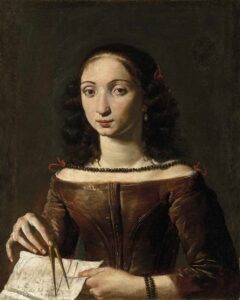Loretta Pettinato

Artemisia Gentileschi, Fede Galizia, Sofonisba Anguissola and many others, are some of the painters who lived between the sixteenth and seventeenth century; some are better known than others, but they all fought bravely against violence and provocations, managing to force their art in the Italian culture and other countries. Other than leaving a remarkable artistic heritage, they also testify what can be achieved when genius and determination mix and integrate together. Bravery, determination and passion marked the life of another artistic figure who lived during the same period of time and can probably be considered the most exceptional one: Plautilla Bricci, painter but most importantly first and only female architect in Italy and Europe. She was so extraordinary that the new word “architettrice” (meaning female architect) was coined specifically for her, as documented in a notarial contract of the 1600s, in regards to the construction of a mansion in Rome. The writer Melania Mazzucco named her 2019 best-seller with this new term, bringing the life of this woman, who had been mostly unknown up until a couple of years ago, to public’s attention.
Plautilla was born in 1616 and lived during the Rome of the Popes, the historical period in which artists worked in workshops, seeking for the protection of nobles and prelates against jealousies, slanders and crimes. Her origins were poor and although destined to a mediocre life, she was lucky enough to have a gifted and visionary father, a certain Giovanni Briccio. Apart from sewing mattresses, he was also a poet and painter and became his daughter’s teacher, introducing her to art, music and science.
Now in Rome, the National Gallery of Ancient Art is hosting an exhibit titled “A silent revolution. Plautilla Bricci painter and architettrice”, open from November 5th 2021 to April 19th 2022. There are about thirty art pieces, among which one can find the altarpiece depicting “San Luigi of France between history and faith” and the canvas “Madonna with Child”. This painting was the breakthrough in the artist’s professional life, as it was considered prodigious. As a matter of fact, Plautilla shared how she found the painting completed in all its beauty after various attempts at completing it, in a document discovered behind the canvas, considering this a divine intervention. Following this miracle, Plautilla became famous and was admitted into the painter’s sAcademy and in the best workshops, where other important artists such as Bernini and Pietro da Cortona worked. But what became crucial was her encounter with the priest Elpidio Benedetti, prominent figure of the political life and of the artistic relationship between Rome and Paris during the seventeenth century. This fellowship was what allowed Plautilla to make her dream come true: the construction of a mansion planned and designed by herself. The construction of Villa Benedetta, which later on became the Roman residence of priest Elpidio, began between 1662 and 1663. It is fascinating how Mazzucco described in her book the holy ceremony held for the laying of the first stone, in which a metal sheet, engraved with the architect’s name, was blessed. The mansion was a baroque building which developed vertically, soaring on the Gianicolo hill like a ship; as a result, in the 1700s it was described as a big war vessel, lacking only the mast and veils. The internal walls were completely covered in frescoes, framed by well-wishing decorations.
Sadly, there are only a few traces left of the mansion, as it was almost completely destroyed during the French siege in 1849. Nevertheless, one can see the restored documents and projects in the exhibit, where there is also the portrait of a young woman, presumably Plautilla. This woman has a round face, dark hair, a curved nose and widespread eyes, slightly crooked. She is holding a sheet of paper with a project on it with her left hand and a protractor with the right one. These objects are like symbols of the extraordinary life of this brilliant and strong-willed woman, nicknamed “the Roman spinster” who, thanks to her choices and sacrifices, was able to make her dream come true in an hostile environment and a working field which still nowadays has close to no “architettrici”.
